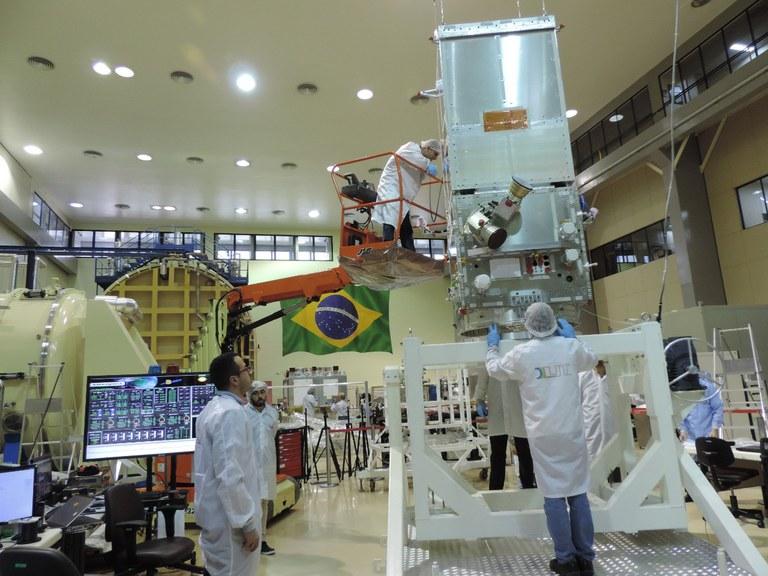Amazonia 1 opens new horizons for the national industry

Photo: INPE
With the successful launch of Amazonia 1, the first Earth observation satellite 100% designed, tested, integrated and operated nationally, Brazil is now mastering the complete development and operation cycle of this equipment and opening new horizons for companies in the aerospace sector. Around 60% of the budgetary resources for the development of the satellite were allocated to contracts signed with the national industry for the development and manufacture of subsystems and equipment. Composed of a payload module and a service module, the satellite has solar generators, propulsion systems, cameras, antennas and a digital data recorder, all developed in Brazil. According to Célio Vaz, president of Orbital Engenharia, responsible for solar generators, “the international market values not only expertise, but the number of flight hours of equipment in space.” Created in 2000, the company has already supplied products for other satellites of the National Institute for Space Research (INPE/MCTI), such as CBERS 2B, CBERS 3 and CBERS 4 and 4A, and today it already exports solutions. “In this area of space, it is not enough to just know how to do it, but experience counts. We export cubesat panels to the private sector in England. This means the flight history barrier starts to come down. For us, participating in a successful mission like Amazonia 1 is a source of pride and the crowning achievement of all our years of effort and work. With development work, we are generating highly specialized and competent jobs”, he states. Launched on February 28, by the Satish Dhawan Space Center, in Sriharikota, India, the satellite was greatly celebrated by national authorities who traveled to India. They all also highlighted the new possibilities for aerospace companies in Brazil. “Amazonia 1 is a satellite of national production, national design. It is important to emphasize that this is not the work of one person, it is the work of a very large team. A launch like this brings together a lot of efforts. The fact of the construction itself, the fact that we have, on the satellite, the multimission platform that can be used for other satellites, this gives us the possibility of having the industry
working in Brazil on this development, which will be used in satellites for other purposes as well”, stated minister Marcos Pontes.
“I can say that this day represents the consolidation of a process of gaining knowledge and maturity for Brazil in the area of satellite development – and this day is a watershed. We are, once again, fulfilling our mission, we have placed in orbit a device that meets the national demands for monitoring the Brazilian Amazon and increases our knowledge in order to allow the monitoring of our harvests”, highlighted the director of INPE/MCTI, Clezio de Nardin. “This satellite is a milestone in countless ways and also a milestone in the multimission platform, both due to the history of the project, its importance and the return that the project will promote for society, and also a return to the creation of the space market, which is something important for all of us”, said the president of the Brazilian Space Agency (AEB/MCTI), Carlos Moura. Amazonia 1: 100% national remote sensing satellite The images captured by the satellite will be used to monitor deforestation in the Amazon, coastal regions of the country, environmental disasters, water reservoirs and forests, in addition to supporting the agribusiness sector. Amazonia 1 is the first built using the Multimission Platform (PMM), an innovative structure developed by INPE/MCTI, capable of adapting to the purposes of different missions and, thus, reducing the costs of space projects. The platform has altitude control, orbit, propulsion, solar generator, energy supply and mechanical structure subsystems that guarantee the operation of the satellite in orbit. The satellite weighs around 640 kg, is 2.5 m tall, and has a wingspan of approximately 7.5 m with the solar panels open. Equipment on board, interconnected through 6km of cables, the solar panels have an area of more than 6m² that allows them to generate power in the order of 1,000 watts, until the end of their useful life. Although Brazil has already launched six remote sensing satellites, Amazonia 1 is the first completely designed, integrated, tested and operated by our country. Its construction represents a technological achievement and a great achievement for the public institutions involved, the national industry and the Brazilian Space Program. This allows you to acquire more autonomy to act on missions in this category and move towards more complex space missions. It also means gaining capacity to work at all stages, in all mission subsystems in national or international partnerships. About AEB The Brazilian Space Agency, the central body of the National System for the Development of Space Activities (SINDAE), is an agency linked to the MCTI, responsible for formulating, coordinating and executing the Brazilian Space Policy. Since its creation, on February 10, 1994, the Agency has worked to facilitate the efforts of the Brazilian State to promote the well-being of society, through sovereign employment in the space sector.
Source: Coordenação de Comunicação Social – CCS/AEB

